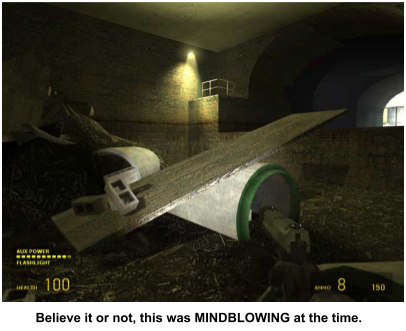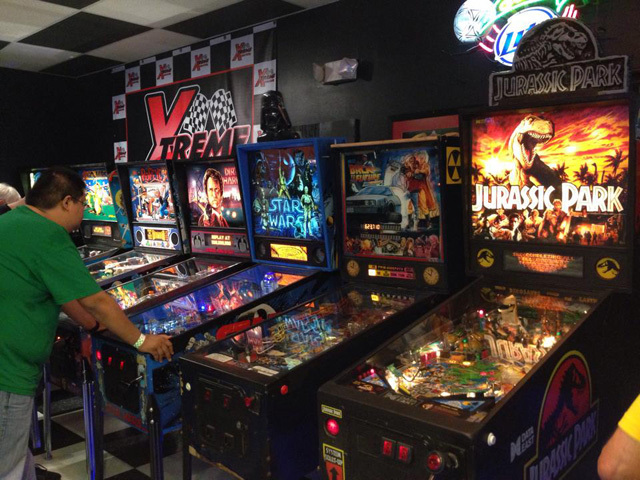Some say that the best video games are the ones which have a thought-out story complemented by creative gameplay mechanics which keep the pacing fresh and fun throughout the whole ordeal. Moreover, while some may agree with the statement, there has been a growing trend among single player video games, where mechanical freedom makes up the most part of the gameplay, with great success. In these games, the player is free to do whatever he desires, and is not necessarily bound to fulfill the main story quest as soon as he gets control of the character. Additionally, these titles are usually open-ended and contain massive, sprawling worlds filled to the brim with objects the player can interact with and collectibles which allows him to get around and overcome the obstacles the world has in store.
When it comes to these games, the creativity of the player is the main factor which will both drive and limit the things he can achieve. Additionally, the things he can achieve, in turn, will be directly dependant on the underlying mechanics of said game. The vast amount of freedom, coupled with the numerous set pieces which can be interacted with have earned these games the title of “sandboxes”. A typical example of these types of video games is the ever-popular Grand Theft Auto franchise where the player takes control of a character which can run, drive, and shoot his way through the city and engage in general shenanigans. The more modern GTA games such as IV and V have their own physics engine implemented, so the player can fool around at breakneck speeds and get a ton of fun from being shot out the windshield of his car after the inevitable crash against a rogue tree or lamppost. That’s not to say that these games don’t have great plots; I’ve experienced plenty of interesting plots in my 20-something years as a gamer, and I can personally attest to the quality of the stories written by Rockstar (the creators of GTA). However, a big chunk of the fun of sandboxes come from the interactions with the gaming world, and the carefully-written and engaging story is just the icing on the very tasty cake.

GTA has been around for a while now; the original game was released in 1997 for the Playstation, However, the first time I played it, I couldn’t get immersed enough to actually enjoy it; the gameplay was innovative in that sandbox elements, albeit in this rudimentary state, were not very common at the time, but since the story was somewhat shallow (games were not yet at the level of movies and books when it came to compelling narratives, at least not as much as today), I had a hard time getting hooked on them. The second was similar to the first, but slightly better in graphics and with different weapons. The third, however, came with the big leap into 3D; the game was switched from a top-down perspective to a third-person camera with full freedom to move wherever the player pleases. The leap to the Playstation 2 also came with better graphics, and the console’s hardware also allowed for bigger explosions and more fun, in general. The series could only improve from there.
Grand Theft Auto is an extremely fun sandbox and, if you enjoy messing around in a sprawling world, then you’ll definitely get your money’s worth if you invest in any game of the popular series. Nevertheless, the physics-based freedom and complex sandbox elements didn’t come until its fourth installment, and later refined to near-perfection in the fifth, which came out in 2008 and 2013, respectively. However, my very first memory of physics as a vital gameplay element was from 2004, when I first experienced the marvel that is Half Life 2. One of the selling points of this game, besides the unexpectedly awesome narrative — which is compounded when you consider the game’s silent protagonist — is the ability to use physics to your advantage in many of the its stages. The most iconic example of this is in the beginning of the game when the player is presented with a seesaw puzzle. The idea was that you needed to move pieces of rubble onto one side of the seesaw so that, in a wonderful display of coded physics, the opposite end could carry your weight without descending, allowing you to climb on a nearby ledge.

Alongside physics puzzles, Half Life 2 also introduced the Gravity Gun. This fancy piece of hardware allows you to take rubble, rocks, crowbars, and even serrated blades which happen to be lying on the ground, and chuck them at your enemies at full speed; the speed at which the objects would travel would directly influence the damage they inflict on the enemies. This may sound trivial by now, but it was actually pretty innovative in its time, since it granted players with additional means to dispatch enemies, other than shooting them like in other FPS games.
In my opinion, Half Life was a trendsetter when it came to innovative FPS mechanics. It is one of very few shooters in which the gameplay revolves around more than shooting; Valve has managed to create stages that, despite being entirely linear, prompt the player to use their wits in order to overcome obstacles in which their weapons fail to cause effect. And all of these elements are tied together by an incredible plot and narrative which manages to be engaging throughout the whole game without so much as feeling slow or boring at most times. I’m looking at you, Route Kanal; you know what I’m talking about.
However, one game that I’m particularly hooked with due to its generous attention to detail and staggering amount of liberties that you can take with the mechanics is none other than Nintendo’s latest installment in the Zelda franchise: The Legend of Zelda: Breath of the Wild.
Unlike its predecessors, BotW presents players with a vast, expansive world with seemingly no specific objectives other than to “stop the bad guy”. Whatever you choose to do once you leave the tutorial area is fair game; you can tame horses, engage in combat with different enemies walking around the world, power up the runes in your Sheikah Slate, and even take on the final boss from the very beginning (a very, very difficult task in your initial, weakened state). Heck, the series’ iconic evil-sealing sword — the Master Sword — is an optional piece of equipment in the latest Zelda game, considering that you can beat it without ever searching for it at all.
However, playing with set pieces, as I’ve been pointing out in this article is nothing new to video games. Despite offering tons of gameplay with its overwhelming amount of content, Breath of the Wild excels for its brilliant programming which allows player to complete puzzles in a very wide variety of methods, including those not anticipated by the developers themselves. The tools the player is provided with, coupled with an absolutely remarkable physics engine make for an awesome combination that results in totally unique scenarios every single time you pick up the game.
The video above is a great way to illustrate this point. As the description suggests, the players need to find a second electrical orb to power the bulb and unlock the gate. However, the game is programmed so that all metallic objects can conduct electricity, including Link’s weapons. Since the player is too lazy to search for the orb, he comes up with the brilliant idea of using all his weapons as a makeshift connection to transfer electricity from one pedestal to the next, effectively unlocking the door and allowing him to proceed.
And this is just a sample of the freedom that BotW offers its players. There are tons of ways and methods you can approach any specific obstacle and still come out victorious. Barring a few scenes and battles, there is very little scripted content, so whatever happens is, basically, a result of the player’s interactions with the world. And this, my friends, is what mechanical freedom is all about. No scripts, no cutscenes; just good ol’ world building and interaction.
I could go on and on about all the stuff you can do in this game but, in all honesty, you should really just go out and experience it for yourself when you have the chance. I promise that you won’t be disappointed.
Here at PrimeTime Amusements, we’re always working hard to provide you with the very best solutions in arcade game sales and rentals. If you’re looking for a specific amusement, or would like to know more about a certain machine, feel free to call us at 1.800.550.0090 or to pay us a visit at 5300 Powerline Rd, Suite 210, Ft. Lauderdale, Florida, 33309.





